How to implement reverse proxy using Nginx in php
This article mainly introduces in detail the method of using Nginx to implement reverse proxy in PHP. It has certain reference value. Interested friends can refer to it
1. Proxy server
1. What is a proxy server?
Proxy server, when the client sends a request, it will not be sent directly to the destination host. , but is first sent to the proxy server. After the proxy service accepts the client's request, it sends it to the host, receives the data returned by the destination host, stores it in the hard disk of the proxy server, and then sends it to the client.
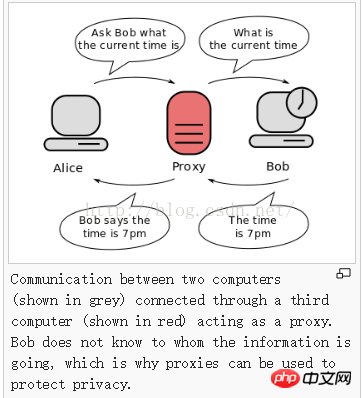
2. Why use a proxy server
1) Improve access speed
Since the data returned by the target host will be stored in the hard disk of the proxy server, the next time the customer accesses the same site data, it will be read directly from the hard disk of the proxy server, which plays a cache role, especially for Popular sites can significantly increase request speeds.
2) Firewall function
Since all client requests must access remote sites through the proxy server, restrictions can be set on the proxy server to filter certain unsafe information.
3) Access inaccessible target sites through proxy servers
There are many developed proxy servers on the Internet. When access is restricted, clients can access the target through unrestricted proxy servers. Site, in layman's terms, the circumvention browser we use uses a proxy server. Although it cannot go abroad, it can also directly access the external network.
2. Reverse proxy VS forward proxy
1. What is a forward proxy? What is a reverse proxy?
Forward proxy is set up between the client and the target host. It is only used to proxy the connection request from the internal network to the Internet. The client must specify the proxy server and send the request directly to the Web server. HTTP requests are sent to the proxy server.
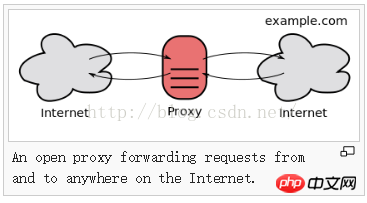
The reverse proxy server is set up on the server side. It relieves the workload of the server by buffering frequently requested pages and forwards client requests to the internal network. The target server; and returns the results obtained from the server to the client requesting a connection on the Internet. At this time, the proxy server and the target host appear as a server to the outside world.
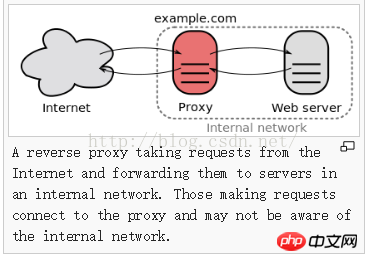
#2. What are the main applications of reverse proxy?
Many large web sites now use reverse proxies. In addition to preventing vicious attacks from the external network on intranet servers, caching to reduce server pressure and access security control, it can also perform load balancing and distribute user requests to multiple servers.
3. Directional proxy server Nginx
Nginx, as a popular reverse proxy server in recent years, is installed on the destination host and is mainly used to forward client requests. There are multiple HTTP servers in the background to provide services. The function of nginx is to forward the request to the subsequent server and decide which target host to handle the current request. The following demonstrates how to configure Nginx to function.
1. Simulate n http servers as target hosts
For testing, simply use 2 tomcat instances to simulate two http servers, and change the tomcat ports to 8081 and 8082 respectively
2. Configure IP domain name
192.168.72.49 8081.max.com
192.168.72.49 8082.max.com
3. Configure nginx.conf
upstream tomcatserver1 {
server 192.168.72.49:8081;
}
upstream tomcatserver2 {
server 192.168.72.49:8082;
}
server {
listen 80;
server_name 8081.max.com;
#charset koi8-r;
#access_log logs/host.access.log main;
location / {
proxy_pass http://tomcatserver1;
index index.html index.htm;
}
}
server {
listen 80;
server_name 8082.max.com;
#charset koi8-r;
#access_log logs/host.access.log main;
location / {
proxy_pass http://tomcatserver2;
index index.html index.htm;
}
}Process:
1) Access 8081.max.com with the browser and find the 192.168.72.49 server through local host file domain name resolution (install nginx )
2) The nginx reverse proxy accepts the client request, finds the server node with server_name 8081.max.com, and forwards the request to upstream tomcatserver1 according to the http path corresponding to proxy_pass, that is, the port number is 8081 tomcat server.
4. Effect display
Request 8081.max.com, tomcat1 receives and returns to the home page
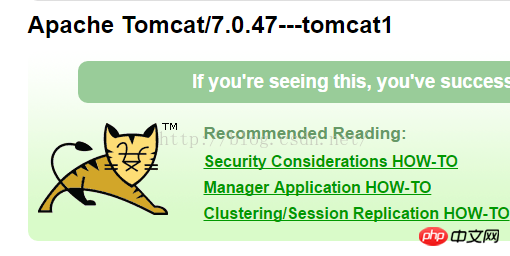
Request 8082.max.com, tomcat2 Receive and return to the homepage
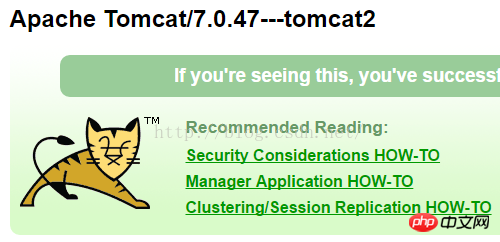
## IV. Summary
Through analysis, it is not difficult to conclude that, taking Baidu as an example, if the customer If the IP of the computer and the IP of Baidu server (target host) are in the same network segment, it will be like sending a request within the LAN, and the speed is extremely fast.But if this demand cannot be met and you still want to achieve a better request response, Baidu server can provide a public network IP in the same network segment as the target server, which is the IP of the reverse proxy service, through The proxy server forwards the client request and determines which of the N servers behind the scenes will handle the request. Since the reverse proxy server is on the same network segment as the target host, the access speed will be very fast.
When Nginx is used as a reverse proxy server, it is one of many reverse proxy servers. Through simple configuration, the client request can be forwarded to the designated server for processing by specifying the server IP or domain name address. ask.
The above is the detailed content of How to implement reverse proxy using Nginx in php. For more information, please follow other related articles on the PHP Chinese website!

Hot AI Tools

Undresser.AI Undress
AI-powered app for creating realistic nude photos

AI Clothes Remover
Online AI tool for removing clothes from photos.

Undress AI Tool
Undress images for free

Clothoff.io
AI clothes remover

AI Hentai Generator
Generate AI Hentai for free.

Hot Article

Hot Tools

Notepad++7.3.1
Easy-to-use and free code editor

SublimeText3 Chinese version
Chinese version, very easy to use

Zend Studio 13.0.1
Powerful PHP integrated development environment

Dreamweaver CS6
Visual web development tools

SublimeText3 Mac version
God-level code editing software (SublimeText3)

Hot Topics
 1376
1376
 52
52
 PHP 8.4 Installation and Upgrade guide for Ubuntu and Debian
Dec 24, 2024 pm 04:42 PM
PHP 8.4 Installation and Upgrade guide for Ubuntu and Debian
Dec 24, 2024 pm 04:42 PM
PHP 8.4 brings several new features, security improvements, and performance improvements with healthy amounts of feature deprecations and removals. This guide explains how to install PHP 8.4 or upgrade to PHP 8.4 on Ubuntu, Debian, or their derivati
 How To Set Up Visual Studio Code (VS Code) for PHP Development
Dec 20, 2024 am 11:31 AM
How To Set Up Visual Studio Code (VS Code) for PHP Development
Dec 20, 2024 am 11:31 AM
Visual Studio Code, also known as VS Code, is a free source code editor — or integrated development environment (IDE) — available for all major operating systems. With a large collection of extensions for many programming languages, VS Code can be c
 How do you parse and process HTML/XML in PHP?
Feb 07, 2025 am 11:57 AM
How do you parse and process HTML/XML in PHP?
Feb 07, 2025 am 11:57 AM
This tutorial demonstrates how to efficiently process XML documents using PHP. XML (eXtensible Markup Language) is a versatile text-based markup language designed for both human readability and machine parsing. It's commonly used for data storage an
 PHP Program to Count Vowels in a String
Feb 07, 2025 pm 12:12 PM
PHP Program to Count Vowels in a String
Feb 07, 2025 pm 12:12 PM
A string is a sequence of characters, including letters, numbers, and symbols. This tutorial will learn how to calculate the number of vowels in a given string in PHP using different methods. The vowels in English are a, e, i, o, u, and they can be uppercase or lowercase. What is a vowel? Vowels are alphabetic characters that represent a specific pronunciation. There are five vowels in English, including uppercase and lowercase: a, e, i, o, u Example 1 Input: String = "Tutorialspoint" Output: 6 explain The vowels in the string "Tutorialspoint" are u, o, i, a, o, i. There are 6 yuan in total
 Explain JSON Web Tokens (JWT) and their use case in PHP APIs.
Apr 05, 2025 am 12:04 AM
Explain JSON Web Tokens (JWT) and their use case in PHP APIs.
Apr 05, 2025 am 12:04 AM
JWT is an open standard based on JSON, used to securely transmit information between parties, mainly for identity authentication and information exchange. 1. JWT consists of three parts: Header, Payload and Signature. 2. The working principle of JWT includes three steps: generating JWT, verifying JWT and parsing Payload. 3. When using JWT for authentication in PHP, JWT can be generated and verified, and user role and permission information can be included in advanced usage. 4. Common errors include signature verification failure, token expiration, and payload oversized. Debugging skills include using debugging tools and logging. 5. Performance optimization and best practices include using appropriate signature algorithms, setting validity periods reasonably,
 7 PHP Functions I Regret I Didn't Know Before
Nov 13, 2024 am 09:42 AM
7 PHP Functions I Regret I Didn't Know Before
Nov 13, 2024 am 09:42 AM
If you are an experienced PHP developer, you might have the feeling that you’ve been there and done that already.You have developed a significant number of applications, debugged millions of lines of code, and tweaked a bunch of scripts to achieve op
 Explain late static binding in PHP (static::).
Apr 03, 2025 am 12:04 AM
Explain late static binding in PHP (static::).
Apr 03, 2025 am 12:04 AM
Static binding (static::) implements late static binding (LSB) in PHP, allowing calling classes to be referenced in static contexts rather than defining classes. 1) The parsing process is performed at runtime, 2) Look up the call class in the inheritance relationship, 3) It may bring performance overhead.
 WordPress site file access is restricted: Why is my .txt file not accessible through domain name?
Apr 01, 2025 pm 03:00 PM
WordPress site file access is restricted: Why is my .txt file not accessible through domain name?
Apr 01, 2025 pm 03:00 PM
Wordpress site file access is restricted: troubleshooting the reason why .txt file cannot be accessed recently. Some users encountered a problem when configuring the mini program business domain name: �...




